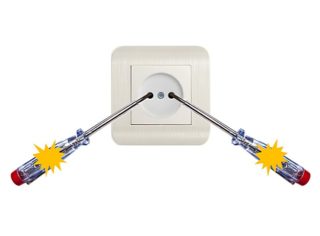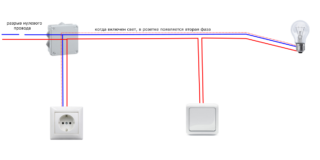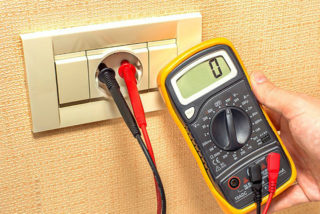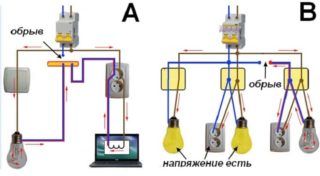A malfunction in which two phases are detected at once in the outlet is a common occurrence in everyday practice. Only an experienced electrician can find its cause. However, with a competent approach, an independent solution to the problem that has arisen is possible. To do this, you will need to familiarize yourself with the principles of forming the supply voltage, which is supplied to each consumer through electrical networks.
Normal distribution of potentials in sockets

Before you figure out why there are two phases in the sockets at once, you should know that a pair of supply conductors is supplied to the apartment through the wiring line, one of which is called phase, and the second is zero. The potential of 220 Volts acts only on one of the terminals of the sockets, and on the second it is equal to zero. You can verify this if you use a conventional indicator screwdriver.
The presence of two potentials (phase and zero) is a prerequisite for the operation of any power supply system.
If there is no phase in the outlet, or for some reason zero has disappeared, it will not be possible to get the difference in their values (220-0 = 220 Volts), called voltage. Therefore, if zero disappeared in the sockets, and how to find it is unknown - before starting the search, you should familiarize yourself with the principle of potential formation. The situation is much more complicated when, instead of zero, another phase appears at the second terminal. To eliminate this malfunction, you will need to understand the reasons for its occurrence.
Reasons for the appearance of two phases

The appearance of a phase on two wires at once can be explained by the following coincidence of circumstances:
- A break in the neutral wire in the entrance panel of a house or apartment.
- Its damage at the input or inside the junction box.
- Lost contact in the connection of "zero" in only one outlet.
- Short circuit of a phase wire to a neutral conductor due to damage to the insulation.
To understand why the indicator shows the phase on both wires at once, the cause that caused each of these phenomena will need to be considered separately.
If there is no zero in the outlet, first of all, you should find the place of its disappearance (breakage). A possible option is damage to the cable at the entrance to the house or apartment, as a result of which "zero" will disappear in all sockets installed inside this building and in separate rooms. In addition, the contact can be broken anywhere in the electrical circuit, including at the input or inside the junction box, which will lead to a failure of only a few outlets.
The second case concerns those of them that are connected within the room to this distribution unit (that is, approximately half), and in all other installation products, a normally working "zero" will remain.
If there is a fault only at the input to a specific outlet, the disappearance of zero and the appearance of the second phase will be observed only in it. In order for the situation under consideration to form finally - the voltage fell on the broken zero contact - it will be required that the bare phase wire accidentally shorted to it.
A variation of the latter case is the option when the zero core is not cut off, and the phase wire with damaged insulation is closed to the ground contact. This will also lead to the appearance of two high potentials in this outlet at once.
Potential consequences and danger of two phases

When there are 2 phases in one or another outlet at once, it is necessary first of all to worry about what this threatens the people using it. This situation is unacceptable for the following reasons:
- The potential difference between the socket terminals will be 220-220 = 0 Volts.
- There will be a power failure, the connected household appliances will not work.
- A danger appears due to the loss of the protective earth circuit, which in old houses acts through the earth core (due to the lack of a local circuit).
In this case, there is no need to talk about any protection at all, the consequences may turn out to be unacceptable for people. An uninformed electrician, considering that the neutral wire (in blue insulation) is touched, may be under high voltage. Therefore, it is prescribed in the regulatory documentation when disassembling the installation products, it is imperative to check the absence of a phase at both terminals by means of an indicator.
In the situation under consideration, all or only the light switches connected to this junction box will also stop working. This is explained by the fact that a phase potential will appear on the neutral wire supplied to the chandelier, connected to the corresponding contact of the socket, and the voltage difference will become zero.
Troubleshooting tips

If two high potentials act on the terminals of the old-style sockets (2 phases and a grounded zero - for new installation products with three contacts) - this situation requires urgent intervention. Since it is associated with a break in the zero core, you first need to find the exact location of the damage using visual inspection methods plus the necessary tool. This will require taking action depending on the nature of the damage.
When the problem affects all the outlets of the residential premises of the entrance or a specific apartment, an electrician should be called who has access to the switch cabinet and the input circuit breaker. If the malfunction is observed only in the apartment (on one / several junction boxes or in a separate outlet), it is possible to eliminate it yourself. To do this, you will need to do the following operations:
- Disconnect the input machine located in the common corridor and supplying voltage to the entire apartment.
- Examine the switch box, at the entrance of which or inside the malfunction is supposed to be hidden.
- If a clear break (bad contact) of the incoming or outgoing wire from the box is detected, it is necessary to restore the broken circuit using the simplest tool - a soldering iron or a screwdriver.
- If the malfunction manifests itself only on one of the sockets, you should remove its cover and carefully examine all contacts.
- If you find a loose fastening on the zero terminal, tighten it using a screwdriver.
So that the second phase disappears from the sockets and the chandelier starts to burn again, you will also need to isolate the damaged phase core from the already restored "zero".
Only if the appropriate instructions are followed, it is possible to eliminate the detected malfunction observed in all, half or only one outlet. The appearance of two phases, regardless of the total number of outlets involved, most often occurs when the rules for the use of household electrical products are violated.









The socket cannot have two phases! If it suddenly happened, then there would be 380 volts between the contacts in the outlet! Don't write nonsense if you don't know electrical engineering.
You do not write nonsense
maybe 2 phases until he himself faced it,
IF THE ZERO IS CROSSING AT THE INPUT, A SINGLE PHASE APPEARS THROUGH THE LOAD, IF THE LOAD IS REMOVED, THE SOCKET WILL BE A PHASE ON ONE CONTACT AS INITIALLY.
Sergey is absolutely right! If the outlet has 2 phases, then there will be 380, and not 0!
There may even be 2 phases in the outlet. If the input to the object is 3-phase, and zero is cut off to the object. Then, through a low-resistance load, the phase falls on the neutral wire and there will be much more than 220 volts between the wires of the outlet.
In this case, we were talking about a two-wire system and a break in the zero conductor according to the terms of the article near the consumer, but do not forget that the zero conductor can lose contact even at the very first switchgear and then problems cannot be avoided. Through the neutral conductor from neighboring consumers, the second phase will appear 100%
Sergei, be careful with your conclusions. The article is not talking about different phases, but the same one on two contacts of the socket. See the diagrams in the article.
Sergei is right. in the apartment there is a two-wire circuit, but all three phases always enter the house, and in order to distribute the load on the cables, electricians put different groups of consumers in different phases: for example, entrance 1 phase 1, 2 entrance phase 2, 3 entrance phase 3. even in one entrance, different apartments may be in different phases. And then, if zero broke off at the entrance to the house, through the devices plugged into the sockets in the neighbor's apartment, the second phase will come to you instead of zero, and the outlet will be 380V
Not Phase Two. A tip
The author missed the option of powering the house with a 3x220 network. It was in the distant past, but it still exists now. Then the outlet will have two phases (220 volts), and between "0" and the phase -127 volts! This is where this value came from in household appliances.
And "burnout 0" in the 3x380 network threatens one of the apartments (the one in which the load is less), well, if not a fire, then the failure of many electrical devices. But worst of all, it is not a complete "burning off 0", its "itching"! I removed the load - "0" is in place, the load is turned on - there is nothing and there is no device, and "0" again seems to be in place ...
Alexey, I completely agree with you, such transformers are still in use, moreover, they are connected not by a star, but by a triangle. There is no zero on them at all.